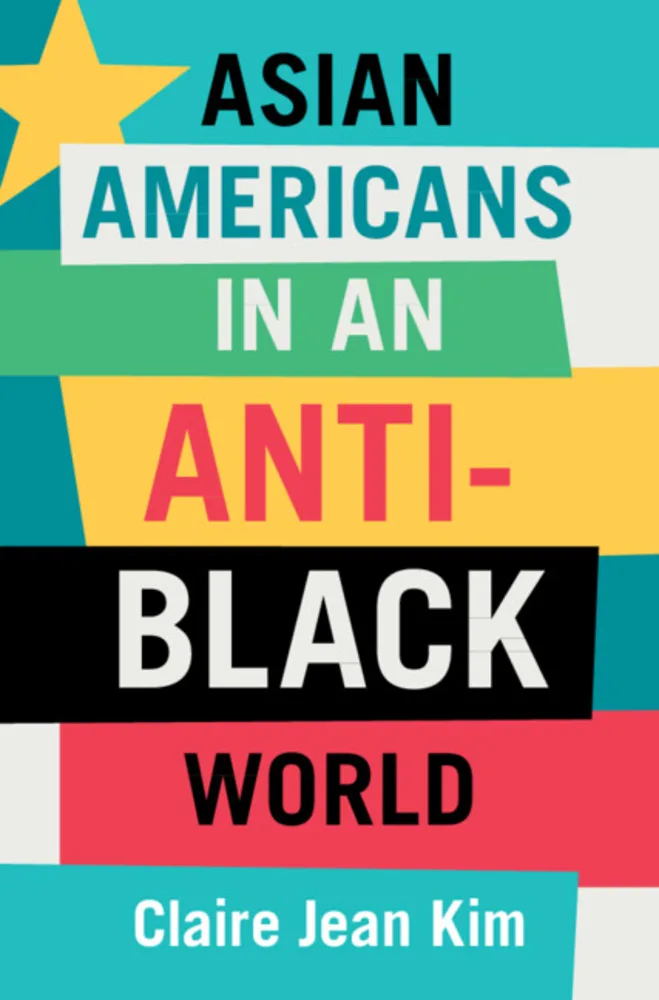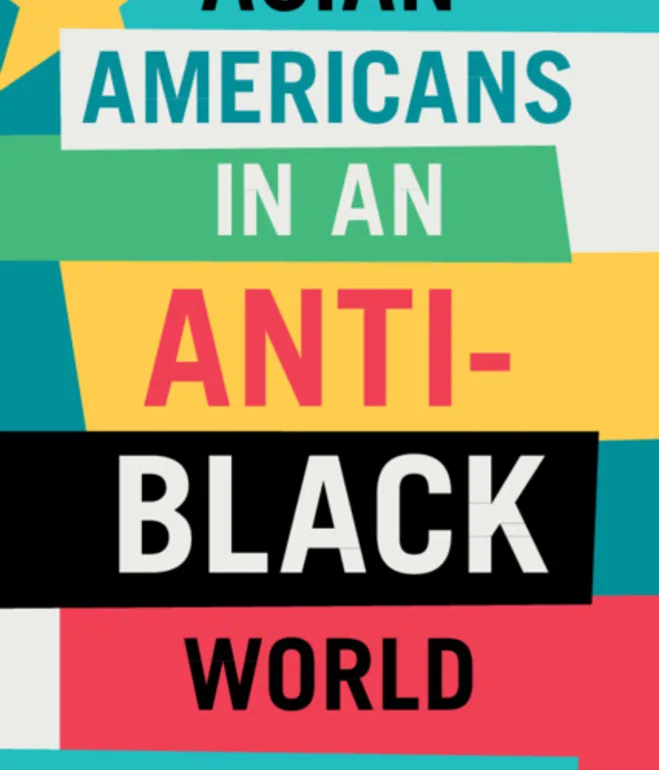
IN THE CLIMACTIC scene of Spike Lee’s classic 1989 film Do the Right Thing, a throng of Black residents of Brooklyn’s Bed-Stuy neighborhood destroy a white-owned business to express their rage at the police murder of a community member. As they begin to seek the next outlet for their grief, a Korean store owner emerges from his shop and attempts to defuse the crowd. Wildly waving a broomstick and yelling in heavily accented English, he offers a simple plea: “I’m not white! I’m black! […] You, me—same.” The scene’s power lies in its ambiguity: is the shopkeeper’s appeal a righteous call to solidarity among people of color, or an outlandish claim to sameness that ignores his privilege in an anti-Black system? His pleas are met with a similarly ambiguous response, drawing both laughter and outcry, until one member of the group disperses the crowd, calling on them to “leave the Korean alone […] he’s all right.”
More than 30 years later, the scene bears resonance for its depiction of the vexed position of Asian Americans in a racial order founded on anti-Blackness. Over the last decade, a generation of Asian Americans politicized in the era of Black Lives Matter have grasped for the language to apprehend the role they might play in struggles for racial justice. Should they, like Lee’s Korean shopkeeper, rely on appeals to shared experiences under a universalized white supremacy? Or does solidarity require delineating anti-Blackness from anti-Asian racism and insisting on the relative privilege of Asian Americans in an anti-Black system?
In her new book Asian Americans in an Anti-Black World, political scientist Claire Jean Kim offers a comprehensive engagement with such questions by reframing Asian American history through the lens of structural anti-Blackness. Influenced by Black studies thinkers such as Frantz Fanon, Frank B. Wilderson III, and Saidiya Hartman, Kim foregrounds the singularity of anti-Blackness and its distinction from other forms of racism. Kim argues that while white supremacy has impacted Asians and Asian Americans through regimes of imperialism and exclusion, anti-Blackness—as the foundation of modernity’s racial order—has operated not as an analogue to anti-Asian racism but as “a structural force that curbs and delimits it.” Asian American racialization must then be understood through the interplay of both white supremacy and anti-Blackness, a dynamic that valorizes Asian American non-Blackness as a “vital form of property” and has legitimized Asian American political claims despite their non-whiteness.
Asian Americans in an Anti-Black World offers a bold revision of the foundations of Asian American studies, whose focus on white-on-Asian domination, Kim argues, has obscured the role of anti-Blackness in Asian racialization. The book is comprised of three sections that retread familiar topics in Asian American history, from the 1882 Chinese Exclusion Act to the World War II incarceration of Japanese Americans to the 1968 emergence of the Asian American movement. In each of these cases, Kim argues that anti-Blackness structured the “broader racial, economic, and political picture” in which Asian American historical actors operated. To this end, each section is interspersed with vignettes of contemporaneous moments in Black history—from the brutality of post–Civil War lynching campaigns to the Cold War surveillance of Black radicals under the FBI’s COINTELPRO program.
In part one, “Exclusion/Belonging,” Kim argues that the 19th-century treatment of Chinese migrants was shaped not only by their definition as non-white but also by their status as non-Black. As the Chinese population on the US West Coast swelled in the decades after the California Gold Rush, Chinese in the United States were cast as cultural and economic threats to the white nation. Anti-Chinese racism was codified by the Chinese Exclusion Act, which banned entry for Chinese laborers and barred Chinese immigrants from naturalizing as citizens. Chinese exclusion created a broader paradigm of Asian exclusion: the Immigration Act of 1917 expanded ineligibility for citizenship across the Asian continent, a law that stood until 1952.
Kim deftly synthesizes secondary scholarship and close readings of historical court cases to expand this narrative. She demonstrates how the so-called “Chinese Question” was staked to debates over the boundaries of free labor in the aftermath of slavery’s abolition. An ideology of Chinese “not-Blackness” was formative during this era, emanating alike from exclusion advocates who mobilized antislavery laws to cast Chinese migrants as “coolies” and Southern plantation owners who imagined Chinese laborers as a more docile alternative to enfranchised Black workers.
Though exclusion hinged on the presumed intractable foreignness of Chinese migrants, Kim argues that foreignness nonetheless functioned as a form of belonging—if not to the US nation, then to the Family of Man. Where tropes of African barbarity cast Black people as blank slates fit for the “civilizing” project of slavery, Chinese migrants were deemed threatening precisely because they possessed a civilizational heritage. As anti-Chinese advocate Reverend Samuel V. Blakeslee described to Congress, the Chinese threat stemmed from the fact that “[t]he Chinaman despises our civilization. […] He tells us in our face, ‘You are small potatoes; we were a great nation three thousand years ago.’” Chinese in the United States at times laid claim to these civilizational arguments, mobilizing anti-Blackness to spotlight the injustice of exclusion. In 1882, the noted Chinese American journalist Wong Chin Foo described the humiliation felt by Chinese who witnessed Black Americans “from the wilds of African jungles” enjoying the fruits of US citizenship while Chinese, “the descendants of the oldest race on earth,” stood watching from beyond the nation’s gates. Even in the Caribbean context of Chinese indentured labor, Kim notes an 1864 Cuban ruling that coolie contracts could not be sold to a free Black person. Anti-Blackness was intractable, even in relation to the institution of Asian indentured labor.
Like the preceding anti-Chinese movement, Japanese migration to the United States at the turn of the 20th century was met with calls for exclusion. Part two, “Ostracism/Initiation,” follows this trajectory of exclusion, which culminated in the World War II incarceration of some 127,000 Japanese in the US. Despite the sheer force of anti-Japanese racism, Kim argues, Blackness “provided a floor beneath which Japanese Americans could not fall.” As subjects of Japan, a growing imperialist power, early Japanese migrants had recourse to diplomacy and international law that Black Americans lacked, setting parameters on their treatment. For instance, through the 1907–08 “Gentlemen’s Agreement” between the United States and Japan, the Japanese government agreed to limit Japanese emigration if the US would ensure that Japanese students in California were spared the humiliation of attending segregated schools—an indignity precisely because it placed overseas Japanese in proximity to Blackness. Even during World War II, Japanese Americans incarcerated in the Jim Crow South enjoyed the privileges of non-Blackness. At the concentration camp at Rohwer, Arkansas, incarcerees who had occasion to leave the camps for shopping, school trips, and the like found themselves expected to occupy the white strata of the Jim Crow binary. When the Rohwer camp was set to close towards the end of the war, Japanese American incarcerees even joined alongside white camp administrators to perform an “All-American Minstrel Show.” In the heart of an American concentration camp, this blackface performance reflected how the adoption of anti-Blackness functioned as an initiation into the US mainstream.
Kim harps on the fact of Chinese and Japanese American non-Blackness not to prove a semantic point but because the post–World War II popularization of model minority narratives hinged on what Kim describes as the “fallacy of minority equivalence.” Part three, “Solidarity/Disavowal,” makes this clear. In the postwar era, sociologists and policymakers theorized racial prejudice as a homogeneous phenomenon that could be compared across minority groups. For instance, Daniel Patrick Moynihan, author of the influential 1965 report on the “Negro family,” contrasted Black poverty with the upward mobility of Asian Americans. In correspondence with President Johnson, Moynihan noted that the Chinese and Japanese in the United States had been “subject to the worst kind of racial discrimination and mistreatment.” By setting up anti-Asian racism as equivalent to—or even surpassing—anti-Blackness, pundits and politicians alike could theorize poverty, crime, and education rates in Black communities as the consequence of inherent deficits rather than symptoms of ongoing institutional anti-Blackness. In short, if Asian Americans could succeed in the face of the “worst kind” of racism, why not Black Americans? As Kim shows, this false equivalence has taken root in diverse political contexts, from legal arguments over affirmative action to debates over reparations and police brutality.
Yet Kim argues that the fallacy of minority equivalence is not unique to conservative politics but has also hindered progressive attempts at building cross-racial solidarity, such as the Asian American movement of the 1970s. This movement, which in 1968 invented “Asian America” as a political identity, is often invoked as a high point of Asian American radicalism and solidarity. Its critique of racism, imperialism, and capitalism linked the struggles of Asians in the US to those of other Third World peoples—a linkage that consciously placed racial justice in the United States alongside struggles for decolonization in the Global South. Third World unity thus demarcated both a transnational politics of solidarity and a call for interracial unity between Asian Americans and the Black Power, Chicano, and American Indian movements. Kim faults this Asian American Third World framework for emphasizing white supremacy at the expense of confronting the specificity of anti-Blackness. More critically, she charges that it appropriated Blackness for the sake of performing Asian American radicalism. Taking aim at the Red Guards, a San Francisco–based group of Chinese Americans, formed in 1969, whose style of dress (leather jackets) and political platform (a “10-point plan”) echoed those of the Black Panthers, Kim asks: “When do emulation and identification border on erasure and displacement?”
Kim’s insistence on Asian American relative privilege even in contexts of state exclusion and incarceration raises an uncomfortable question: does emphasizing structural anti-Blackness undermine the realities of anti-Asian racism? As a field, Asian American studies has committed itself to detailing the racial victimhood of Asian Americans in the face of dominant framings of Asian Americans as model minorities. In this context, the task of taking seriously anti-Asian racism as a formative force in American history has relied either on analogies to anti-Blackness as a historical reference point or on pronouncements that we must move our understandings of race “beyond Black and white.” Kim acknowledges this desire to make visible the unique extent of anti-Asian racism—as she concedes, “Who indeed does not want to be ‘nonderivative?’”—but she nonetheless insists that situating anti-Asian racism alongside structural anti-Blackness equips scholars and activists alike to better apprehend the positioning of Asian Americans under the US racial order.
On this score, Kim’s own earlier scholarship is not safe from her critique of the field’s obfuscation of anti-Blackness. Kim offers a candid revision of her prior concept of racial triangulation theory, an influential model that charted the US racial order across two axes: a superior-inferior scale (y axis) and an insider-outsider (originally insider-foreigner) scale (x axis). While Black people were positioned at the bottom of the superior-inferior axis, Asian Americans were positioned on the outside of the insider-outsider scale—indicating a position of both relative valorization and relative ostracism. In hindsight, Kim sees that the problem with racial triangulation theory is its presumption that Black people occupy an insider position within US society. Drawing from Black studies scholars such as Saidiya Hartman, who traces the persistence of Black unfreedom in the post-Emancipation era, Kim comes to see that the history of Black citizenship reflects not a privileged insider status but a form of continued captivity in the aftermath of slavery.
While Kim is optimistic about the political possibilities of centering an analysis of anti-Blackness in Asian American politics, the political takeaways of the book are more ambiguous. In its skepticism towards existing frameworks of Asian–Black solidarity, Asian Americans in an Anti-Black World is very much a product of a post-BLM era, during which ethnic studies scholars and activists alike have challenged the tendency to presume the common interests of all non-white groups. Over the last decade, academic theories of Afropessimism have insisted that Blackness exists in an inherent position of social death, an argument for the incommensurability of anti-Blackness that has shaped an evolving social justice lexicon, moving from the more unifying (if flattening) “POC” (people of color) to the more enumerative “BIPOC” (Black, Indigenous, and people of color). Meanwhile, the non-white identities of high-profile perpetrators of anti-Black violence (George Zimmerman and Peter Liang, for instance) forced reckonings over the nature of anti-Blackness in Asian American and Latinx communities.
Kim’s thesis—that confronting anti-Blackness remains peripheral to Asian American politics—may seem odd, then, to those who have been steeped in a particular brand of Asian American social justice politics over the last decade. From college campuses to nonprofit trainings, from crowdsourced syllabi to direct actions, language about “confronting Asian American anti-Blackness” has proliferated as a new generation of Asian Americans have attempted to negotiate their relationship to both Black political movements and structural and interpersonal anti-Blackness. For instance, after the 2016 police murders of Philando Castile and Alton Sterling, Asian Americans and Canadians came together to crowdsource a multilingual letter to Asian immigrant parents about anti-Blackness in Asian American communities. Addressed to “Mom, Dad, Uncle, [and] Auntie,” these Letters for Black Lives invoke the nonequivalence of Asian and Black experiences of race in the United States, stating that while “[i]t’s true we face discrimination for being Asian in this country […] [t]he police do not gun down our children and parents for simply existing.”
In calling on Asian Americans to act as “responsible allies” in the struggle for Black lives, these letters are representative of a growing genre of anti-racist literature that seeks to address Asian American anti-Blackness. Yet in emphasizing the relative privilege of Asian Americans vis-à-vis anti-Blackness, they risk obscuring Asian American experiences of racism, state violence, imperialism, and economic exploitation that might form the bedrock of a politics of solidarity. And by privileging conversations with family and community members as a site of political struggle, this genre lends itself towards centering questions of individual feeling and bias over those of movement-building and institutional change.
In some ways, Asian Americans in an Anti-Black World fits comfortably within this genre. But it would be a reduction of Kim’s argument to say that Asian Americans should adopt a position of allyship that reproduces the confessional, feelings-as-politics frame of white anti-racist literature. As Kim acknowledges, the point is not for Asian Americans to “confess that they are complicit in anti-Blackness, so that they might be absolved,” but instead to reimagine Asian American politics as a force that “destabilizes, rather than stabilizes,” anti-Blackness. Yet, as an opening point for Asian American solidarity politics, Asian Americans in an Anti-Black World risks entrenching the same sort of political paralysis as the genre of Asian American anti-Blackness writ large. While the book leverages a plethora of examples of Asian American privilege in an anti-Black system and the limits of historical attempts at coalition, it shies away from examining activist efforts that have successfully navigated these obstacles. Meanwhile, it casts contemporary conflicts such as struggles over affirmative action, the 1992 Los Angeles rebellion, and the trial of NYPD officer Peter Liang as moments where “Asian American interests clash with Black interests,” potentially leaving readers to wonder whether confronting Asian American anti-Blackness necessarily means sacrificing Asian American interests.
Is it possible to excavate a politics of solidarity based on mutual interest and the intersections of white supremacy and anti-Blackness? Here, it is worth clarifying precisely whose interests are represented by efforts to overturn affirmative action or support convicted Asian American police officers. How might incorporating the perspectives of working-class, non–East Asian, undocumented, or incarcerated Asian Americans shift this framing of conflicting Asian–Black interests? Does confronting Asian American anti-Blackness necessarily place Asian Americans in a homogenized position of relative privilege?
To be fair, these questions fall outside the scope of Kim’s inquiry, and the author is forthcoming about the limitations of the book’s focus on East Asian Americans in a domestic US context. The questions that arise from reading Asian Americans in an Anti-Black World are a testament to the analytical scaffolding it provides to meet the demands of our current moment. For instance, how might Kim’s conception of “foreignness as belonging” be tested by 21st-century geopolitics in Asia, particularly rising Sinophobia and the US military’s ongoing “pivot to Asia”? Likewise, moving beyond the book’s focus on Chinese and Japanese Americans, how might Southeast Asian American experiences of criminalization and deportation inform a different kind of Asian–Black coalition?
The answers—or at least the beginnings of them—may rest outside of the scholarly terrain. In December 2014, a group of Bay Area Asian American activists calling themselves Asians4BlackLives joined a direct action at the Oakland Police Department against what they called the country’s “war on Black people.” In what Kim lauds as a “striking exception” to the nontheorization of anti-Blackness, the group acknowledged the ways that Asian Americans have been “used historically to prop up […] anti-Black racism.” Yet the group also chose to gesture to the diverse experiences of Asian Americans with state violence. “Some of us have been targeted, profiled, and killed by U.S. government institutions,” their statement read. “Many of us came to the U.S. as a result of the devastation and displacement caused by the US military and its ‘partners’ in Asia, only to find a country [that] uses police to devastate and displace black communities.” A month later, Asians4BlackLives joined another direct action, this time targeting the Oakland Federal Building. Arms linked to block entry, they unfurled a banner that invoked a longer history of solidarity: “Third World for Black Power.” This persistence of the idea of Third Worldism as a framework for Asian American solidarity offers an alternative way of thinking about Asian American relationships to anti-Blackness. Perhaps enumerating the scope and scale of anti-Asian racisms under systems of white supremacy, imperialism, and capitalism can inform a politics of solidarity that confronts anti-Blackness and anti-Asian racism not as equivalent but as interlocking systems.
¤



